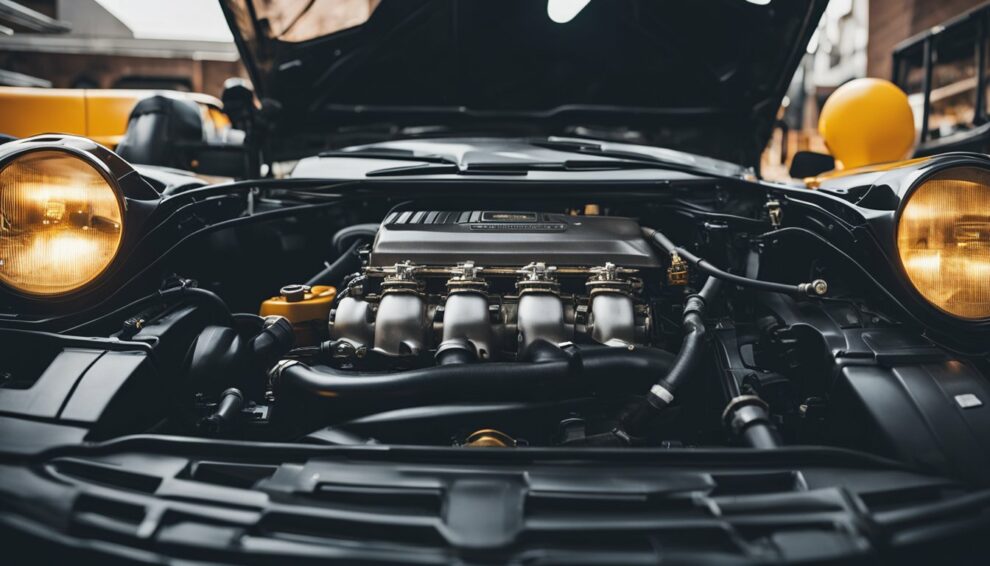You’re driving along, and suddenly your engine starts misfiring, accompanied by rough idling and decreased acceleration. These could be signs that your camshaft is failing.
But what does this mean for your vehicle’s performance and longevity? Understanding these warning signals could save you from costly repairs down the road.
Key Points
- Engine misfires and rough idling are common signs of camshaft failure.
- Decreased acceleration and power output may indicate camshaft issues.
- Loud engine noises and knocking can signal worn camshaft lobes or bearings.
- Poor fuel efficiency and performance could be due to failing camshafts.
- An illuminated Check Engine light may indicate camshaft position sensor problems.
Engine Misfires and Rough Idling
If your engine is experiencing misfires and rough idling, it could be a warning sign of camshaft failure.
Engine misfires can occur due to worn camshaft lobes not opening valves properly, leading to incomplete combustion in the cylinders.
This results in the engine running rough and may even cause it to shake or vibrate during idling.
Rough idling, on the other hand, is often a consequence of the camshaft failing to coordinate valve movements with the piston actions, disrupting the engine’s smooth operation.
Faulty camshafts play a vital role in the combustion process, and when they develop issues, such as worn lobes or improper timing, the engine’s performance is compromised.
Inconsistent combustion caused by camshaft problems can lead to a lack of power and efficiency during idling, affecting your vehicle’s overall drivability.
Addressing these camshaft issues promptly is essential to prevent further damage and ensure efficient engine function. If left unattended, camshaft failures can escalate, resulting in more severe engine problems down the line.
Decreased Acceleration and Power
Experiencing decreased acceleration and power in your vehicle could signal potential camshaft issues.
When the camshaft is bad, it can cause signs of damage that result in reduced engine performance.
One of the common symptoms of a failing camshaft is the loss of acceleration, leading to a noticeable decrease in power output.
If you find that your vehicle is struggling to pick up speed like it used to, it may be due to a faulty camshaft affecting the timing of the valves.
This can result in diminished horsepower and a sluggish response when you press on the accelerator.
Keep an eye out for a drop in engine power and slower acceleration, as they could be indicative of camshaft failure. Addressing these issues promptly is essential to prevent further damage to your engine and maintain peak performance.
Loud Engine Noises and Knocking
When loud engine noises and knocking are present, it may be a sign of worn camshaft lobes or bearings.
The knocking noise you hear is often a result of improper valve timing caused by camshaft wear.
This wear can lead to excessive strain on the engine components, potentially causing serious engine damage if not addressed promptly.
Ignoring the knocking sound can further exacerbate the issue, leading to more severe engine problems over time. To prevent costly repairs and extensive damage, it’s vital to conduct a timely inspection of the camshaft and replace it if necessary.
By addressing camshaft wear and addressing the knocking noise promptly, you can maintain the health and performance of your engine.
How Can a Failing Steering Rack Affect the Camshaft?
A failing steering rack can negatively impact the camshaft by causing erratic and unpredictable steering behavior. Signs of a faulty steering rack include difficulty turning, leaking power steering fluid, and unusual noises while steering. It’s essential to address steering rack functionality and signs promptly to prevent further damage to the camshaft.
Poor Fuel Efficiency and Performance
Experiencing a drop in fuel efficiency or noticing a decline in your vehicle’s performance could indicate a possible issue with the camshaft.
A failing camshaft can lead to decreased fuel efficiency by causing improper valve timing and combustion. This inefficiency in fuel combustion due to camshaft issues can result in decreased mileage and increased emissions.
Also, reduced engine performance can be a consequence of a failing camshaft, impacting acceleration and power output.
The camshaft plays an important role in coordinating the intake and exhaust valves’ opening and closing timings.
When the camshaft is bad or failing, it disrupts this synchronization, leading to poor fuel economy and compromised engine performance.
Addressing camshaft problems promptly is essential to restore efficient fuel efficiency and engine operation.
If you observe a decline in fuel economy alongside a decrease in performance, it may be time to have your camshaft inspected by a professional to prevent further damage.
Check Engine Light Illuminates

If your vehicle’s Check Engine light suddenly illuminates, it could be signaling an important issue with the camshaft position sensor.
The Check Engine light often indicates problems with various engine components, including the camshaft position sensor. When this light comes on, it’s essential to address it promptly to prevent further damage.
The camshaft position sensor plays a significant role in the engine’s performance, and its failure can lead to issues such as rough idling, stalling, or poor acceleration.
Ignoring the illuminated Check Engine light may result in more severe consequences and higher repair costs down the line. To diagnose the problem accurately, it’s recommended to seek professional help.
A mechanic can perform a thorough inspection and use specialized tools to pinpoint the exact cause of the issue.
Alternatively, you can connect a DIY scan tool to the Engine Control Module (ECM) to retrieve error codes and get a better understanding of what triggered the Check Engine light.
Addressing camshaft position sensor problems promptly can help maintain your vehicle’s performance and prevent further complications.
Transmission Shifting Difficulties
Experiencing trouble with shifting gears in your vehicle could be a significant indicator of a failing camshaft position sensor affecting the transmission’s shift solenoids.
When the camshaft position sensor starts to fail, it can provide incorrect data to the engine control module, leading to issues with the transmission’s shifting mechanism.
This can result in transmission shifting problems, causing gears to not engage or shift properly.
In some cases, the engine control module may activate limp-home-mode to safeguard the engine from potential damage caused by the faulty sensor data.
Also, restricted engine speed might occur as a protective measure to prevent further harm when the sensor data is compromised.
It’s important to address these transmission shifting difficulties promptly to avoid further damage to the vehicle’s drivetrain.
If you notice any irregularities with how your vehicle shifts gears, it’s recommended to have a professional mechanic inspect the camshaft position sensor and the transmission system to diagnose and resolve the issue efficiently.
As an Amazon Associate we earn from qualifying purchases.










